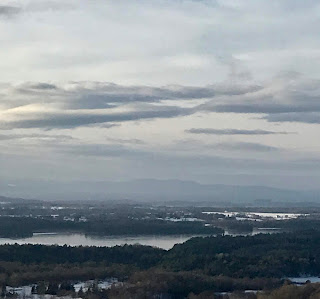P. M. — To Hill.
About three inches of snow fell last evening, and a few cows on the hillside have wandered about in vain to come at the grass. They have at length found that place high on the south side where the snow is thinnest.
How bright and light the day now! Methinks it is as good as half an hour added to the day.
White houses no longer stand out and stare in the landscape. The pine woods snowed up look more like the bare oak woods with their gray boughs. The river meadows show now far off a dull straw-color or pale brown amid the general white, where the coarse sedge rises above the snow; and distant oak woods are now more distinctly reddish.
It is a clear and pleasant winter day. The snow has taken all the November out of the sky. Now blue shadows, green rivers, — both which I see, — and still winter life. I see partridge and mice tracks and fox tracks, and crows sit silent on a bare oak-top.
I see a living shrike caught to-day in the barn of the Middlesex House.
H. D. Thoreau, Journal, November 29, 1858
White houses no longer stand out and stare in the landscape. Compare November 25, 1853 ("The white houses of the village, also, are remarkably distinct and bare and brought very near."); June 12, 1852 ("Nature has put no large object on the face of New England so glaringly white as a white house."); June 24, 1852 ("I have not heard that white clouds, like white houses, made any one's eyes ache.")
The snow has taken all the November out of the sky. See November 13, 1858 (“Thus it comes stealthily in the night and changes the whole aspect of the earth.”); November 28, 1858 (“ Do we know of any other so silent and sudden a change? ”)
I see partridge and mice tracks and fox tracks. See January 7, 1858 ("I notice only one squirrel, and a fox, and perhaps partridge track, into which the snow has blown . . .The mice have not been forth since the snow, or perhaps in some places where they have, their tracks are obliterated.")
H. D. Thoreau, Journal, November 29, 1858
White houses no longer stand out and stare in the landscape. Compare November 25, 1853 ("The white houses of the village, also, are remarkably distinct and bare and brought very near."); June 12, 1852 ("Nature has put no large object on the face of New England so glaringly white as a white house."); June 24, 1852 ("I have not heard that white clouds, like white houses, made any one's eyes ache.")
The snow has taken all the November out of the sky. See November 13, 1858 (“Thus it comes stealthily in the night and changes the whole aspect of the earth.”); November 28, 1858 (“ Do we know of any other so silent and sudden a change? ”)
I see partridge and mice tracks and fox tracks. See January 7, 1858 ("I notice only one squirrel, and a fox, and perhaps partridge track, into which the snow has blown . . .The mice have not been forth since the snow, or perhaps in some places where they have, their tracks are obliterated.")
The snow has taken
November out of the sky --
I see winter life.














